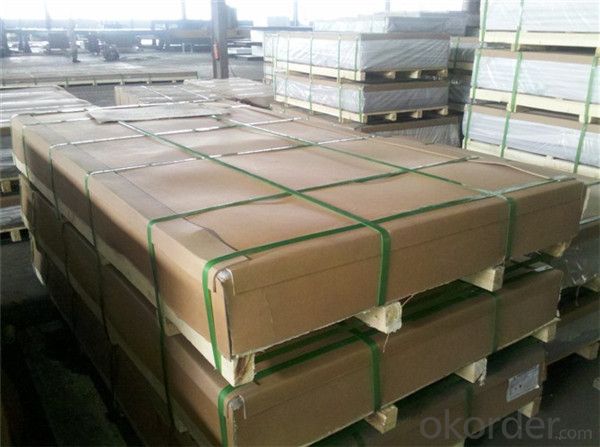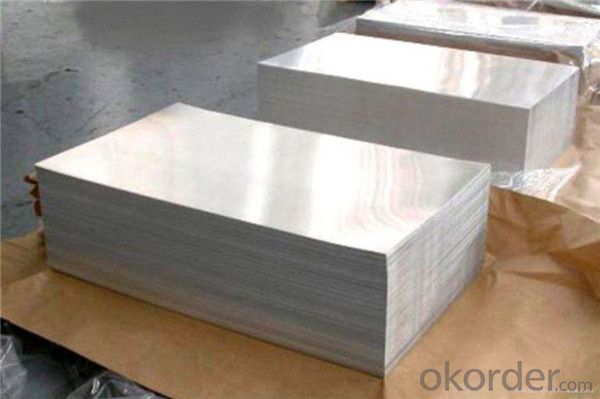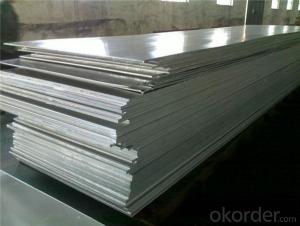Aluminium Sheet/Plate For Kitchen 1100 O H14 H16 H24
- Loading Port:
- Shanghai
- Payment Terms:
- TT OR LC
- Min Order Qty:
- 5 m.t.
- Supply Capability:
- 10000 m.t./month
OKorder Service Pledge
OKorder Financial Service
You Might Also Like
Packaging & Delivery
Packaging Details: | wooden cases is suitable for long distance exporting. |
Delivery Detail: | 30-45 days after receiving L/C or payment in advance |
Decorative Coil/Plate | |
Alloy: | 1100/8011/3003 |
Temper: | H16/H18/H26 |
Thickness: | 0.10mm~0.50mm |
Width: | 1000mm--1300mm |
Tensile Strength: | 155~230Mpa |
Elongation: | ≥2.0% |
T Bend: | within 2T |
PS Board Base | ||
Alloy: | 1060 | |
Temper: | H18 | |
Thickness: | 0.14mm~0.27mm | |
Width: | 300--1250mm | |
Tensile Strength: | ≥140Mpa | |
Elongation: | ≥2.0% | |
Circuit/Lighting sheet | ||
Alloy: | 1060/1100/8011/1050 | |
Temper: | H16/H18 | |
Thickness: | 0.14mm~0.50mm | |
Width: | 300--1250mm | |
Tensile Strength: | 165~195Mpa | |
Elongation: | ||
Brief Introduction for Cold Rolled Steel Coil
Cold Rolled Steel Coil is steel that has been worked below its recrystallization temperature by passing it between a pair of rollers. Recrystallization temperature is the temperature at which grains in the lattice structure of the metal have been rearranged, leaving it free of strain and deformations. Cold Rolled Steel Coil is pre-treated before being cold rolled with a process known as pickling, which uses strong acids to remove scale and other impurities. The Cold Rolled Steel Coil is then passed through rollers to reduce its thickness. Most cold rolling takes place in multiple passes and as the size of the Cold Rolled Steel Coil is further reduced, its strength and hardness both increase, but its ductility decreases. After cold rolling, heating the metal up in a process known as annealing can restore some of its ductility. The final Cold Rolled Steel Coil may be manufactured in the form of sheets, strips, bars, or other forms.
Photos



- Q:Is aluminum a metal or a non-metal?
- Aluminum is a metal.
- Q:How do you join aluminum sheets together?
- There are several methods to join aluminum sheets together, depending on the specific application and desired strength of the joint. Here are some common techniques: 1. Welding: Aluminum can be welded using various methods such as gas tungsten arc welding (GTAW or TIG), gas metal arc welding (GMAW or MIG), or even laser welding. These processes involve melting the aluminum at the joint and adding a filler material to create a strong bond. Welding offers excellent strength and durability but requires skill and appropriate equipment. 2. Riveting: Rivets can be used to fasten aluminum sheets together. This method involves drilling holes through the sheets and using a rivet gun to insert and deform a rivet, creating a secure joint. Riveting is relatively simple and quick, but it may not provide the same strength as welding. 3. Adhesive bonding: Industrial adhesive bonding is a popular method to join aluminum sheets. Specialized adhesives formulated for aluminum bonding are applied to the surfaces, which then cure and form a strong bond. Adhesive bonding is advantageous as it distributes stress evenly and can join dissimilar materials. However, it may not be suitable for high-temperature or high-stress applications. 4. Mechanical fasteners: Screws, bolts, or nuts can be used to fasten aluminum sheets together. This method involves drilling holes and using fasteners to secure the sheets. Mechanical fasteners provide good strength and allow for disassembly if needed. However, they may require additional maintenance and can cause stress concentrations around the holes. 5. Clinching: Clinching is a cold joining method where aluminum sheets are pressed together using a punch and die. The process deforms the materials and creates a mechanical interlock, forming a strong joint. Clinching is a quick and cost-effective method, but it may not be suitable for thin or highly rigid sheets. Ultimately, the choice of joining method depends on factors such as the required strength, aesthetics, cost, and ease of fabrication. It is recommended to consult with a qualified professional or follow specific guidelines to ensure a successful and reliable joint.
- Q:Are the aluminum sheets suitable for manufacturing architectural column covers?
- Yes, aluminum sheets are suitable for manufacturing architectural column covers. Aluminum is a lightweight yet durable material that offers excellent corrosion resistance, making it ideal for exterior applications such as column covers. It can be easily shaped, bent, and fabricated to create custom designs and sizes, allowing for versatility in architectural projects. Additionally, aluminum sheets can be finished with various coatings, such as powder coating or anodizing, to enhance their aesthetic appeal and provide additional protection against weathering and wear. Overall, aluminum sheets provide a great combination of strength, versatility, and aesthetics, making them a suitable choice for manufacturing architectural column covers.
- Q:Can aluminum sheets be used for packaging?
- Yes, aluminum sheets can be used for packaging due to their lightweight, corrosion-resistant, and recyclable properties.
- Q:Are the aluminum sheets suitable for manufacturing heat exchanger tubes?
- Yes, aluminum sheets are suitable for manufacturing heat exchanger tubes. Aluminum has excellent thermal conductivity, corrosion resistance, and is lightweight, making it an ideal material for heat transfer applications.
- Q:I can't seem to find what uses or contains Aluminum Nitride. Help!
- Don't know where you looked, but this came up with very basic web search. Metallization methods are available to allow Aluminium nitride to be used in electronics applications similar to those of alumina and beryllium oxide. Among the applications of Aluminium nitride are opto-electronics, dielectric layers in optical storage media, electronic substrates, chip carriers where high thermal conductivity is essential, military applications, as a crucible to grow crystals of gallium arsenide, steel and semiconductor manufacturing. Epitaxially grown thin film crystalline aluminium nitride is also used for surface acoustic wave sensors (SAW's) deposited on silicon wafers because of the Aluminium nitride's piezoelectric properties. One application is an RF filter used in mobile phones called a thin film bulk acoustic resonator (FBAR). This is a MEMS device that uses aluminium nitride sandwiched between two metal layers.
- Q:Are aluminum sheets easy to clean?
- Yes, aluminum sheets are generally easy to clean. Aluminum is a non-porous material, which means that it does not absorb liquids or stains easily. This makes it relatively easy to wipe off dirt, dust, or spills from the surface of aluminum sheets using a damp cloth or sponge. Additionally, aluminum is resistant to rust and corrosion, so it does not require any special cleaning agents or treatments. However, it is important to note that abrasive cleaners or scrubbing pads should be avoided as they can scratch the surface of the aluminum. Overall, with regular maintenance and proper cleaning techniques, aluminum sheets can be kept clean and in good condition for a long time.
- Q:Can 101 aluminum sheets be used in the production of decorative panels?
- Yes, 101 aluminum sheets can be used in the production of decorative panels. 101 aluminum is a commercially pure aluminum alloy known for its excellent formability and corrosion resistance. These characteristics make it suitable for various applications, including decorative panels. The aluminum sheets can be easily shaped, cut, and fabricated to create intricate designs and patterns for decorative purposes. Additionally, the corrosion resistance of 101 aluminum ensures that the panels will maintain their appearance over time, even in outdoor or high-moisture environments.
- Q:What are the different types of edges available for aluminum sheets?
- There are several different types of edges available for aluminum sheets, depending on the specific application and desired aesthetic. 1. Straight Edge: This is the most basic type of edge, where the aluminum sheet is cut in a straight line with no additional finishing or shaping. 2. Beveled Edge: A beveled edge is created by cutting the aluminum sheet at an angle, usually 45 degrees, resulting in a chamfered or sloping edge. This type of edge is commonly used for decorative purposes or to reduce sharpness. 3. Rolled Edge: A rolled edge is formed by bending the edge of the aluminum sheet, creating a smooth, rounded edge. This type of edge is often used for safety reasons as it eliminates sharp edges. 4. Hemmed Edge: A hemmed edge is created by folding the edge of the aluminum sheet back on itself, resulting in a double layer of material. This type of edge provides added strength and durability and is commonly used for applications where the edge will be exposed or subjected to wear and tear. 5. Tapered Edge: A tapered edge is formed by gradually reducing the thickness of the aluminum sheet towards the edge. This type of edge is often used in aerospace and automotive industries to reduce weight while maintaining strength. 6. Flanged Edge: A flanged edge is created by bending the edge of the aluminum sheet at a right angle, creating a lip or flange. This type of edge is commonly used for applications where the aluminum sheet needs to be attached or joined with other materials. Overall, the choice of edge type depends on the specific requirements of the project, including functionality, aesthetics, and safety considerations.
- Q:How do you prevent warping of aluminum sheets during bending?
- One way to prevent warping of aluminum sheets during bending is by using proper techniques and tools. This includes using the correct bending radius, ensuring even distribution of pressure along the sheet, and employing a suitable clamping method to hold the sheet in place during the bending process. Additionally, preheating the aluminum sheet can help to reduce the likelihood of warping.
1. Manufacturer Overview |
|
|---|---|
| Location | |
| Year Established | |
| Annual Output Value | |
| Main Markets | |
| Company Certifications | |
2. Manufacturer Certificates |
|
|---|---|
| a) Certification Name | |
| Range | |
| Reference | |
| Validity Period | |
3. Manufacturer Capability |
|
|---|---|
| a)Trade Capacity | |
| Nearest Port | |
| Export Percentage | |
| No.of Employees in Trade Department | |
| Language Spoken: | |
| b)Factory Information | |
| Factory Size: | |
| No. of Production Lines | |
| Contract Manufacturing | |
| Product Price Range | |
Send your message to us
Aluminium Sheet/Plate For Kitchen 1100 O H14 H16 H24
- Loading Port:
- Shanghai
- Payment Terms:
- TT OR LC
- Min Order Qty:
- 5 m.t.
- Supply Capability:
- 10000 m.t./month
OKorder Service Pledge
OKorder Financial Service
Similar products
New products
Hot products
Hot Searches
Related keywords





























